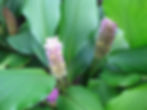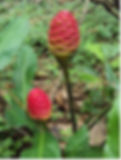Landscaping With a Most Versatile Plant: Gingers!
- Ask a Master Gardener
- Jun 30, 2021
- 3 min read
By: Carol Williams, Mobile County Master Gardener | MobileCountyMasterGardeners.org

Wouldn’t it be wonderful to landscape with a plant that requires little to no maintenance, produces luxurious green leaves, adds fragrant flowers, disappears in the fall, returns in the spring, and can even be eaten! Gingers do all that and more. Fortunately, gingers love our hot and humid summers and are hardy in zones 8-11. At least 1600 species of 50 genera complete the Zingiberaceae family that we commonly call ginger.
Asian cuisine uses the familiar Zingiber officinale, ginger root, in many dishes for every course. In Mobile, it will grow throughout late spring and into fall, when the leaves and rhizomes can be pulled up. Remove the leaves from the rhizome and store it in the freezer for cooking. No defrosting required; simply grate it into the dish. Leave some of the plant in the ground for its return in late spring. This ginger aids digestion, too, and when drunk as tea or ginger ale soothes morning sickness for the expectant mom or seasickness on your fishing trip.
In India, Curcuma longa adds its bright orange color to curries and other dishes. Closer to home, pickles are given their yellow-green color and unique flavor with this same spice, turmeric. In recent years, Americans have taken seriously the medicinal qualities of turmeric as a powerful antioxidant and blood thinner. Growing in moist soil and two to five hours of sun, turmeric will add abundant beauty with its large green leaves and white flowers. The leaves make nice wraps for tamales or as substitutes for grape leaves. This root also harvests easily and can be dried or frozen for future use in soups, tea, even smoothies!
The butterfly ginger, Hedychium coronarium, fills the air with sweet fragrance as its white, pink, orange, or red flowers open. They can be cut for arrangements or left on the plant that ranges from four feet to eight feet tall and two to four feet wide. Two to five hours of sunlight will meet its needs.
A variegated ginger, Alpinia zerumbet 'Variegata' adds spicy fragrance in its yellow and green variegated leaves. Also called the “shellflower ginger,” it produces shell-like white fragrant flowers in drooping clusters near the stem ends throughout the season.
The gingers include low-growing Kamferia varieties, peacock gingers, useful for ground cover. Swirls of bronze, purple, or silver cover their four-to-ten-inch leaves and can thrive in a shady spot. Those who moved from cooler climes might grow these instead of hostas which don’t do well in our coastal zones. Easily divided and removed, peacock gingers make great sharing plants for your neighbors.

A most unusual ginger, the Zingiber zerumber, or pinecone or shampoo ginger, begins with the broad green leaves that reach about four feet tall as they unfurl in the spring. Then in July, their rhizomes shoot up like stems and add bright green pods, looking like pinecones but feeling like leather. Small flowers begin to appear from each bract-like protrusion on the pod. Finally, the pod turns a bright red. After that, a squeeze of the pod yields a clear gel that is used as an ingredient in shampoo. Their beauty makes them worth the trouble of finding a partially shaded spot where these plants can be contained as they can be invasive. Unlike others, pinecone ginger rhizomes are usually too bitter to eat.
The Zingiberaceae family includes so many fragrant, tasty, colorful, and unusual plants. We are fortunate that all its varieties will do well in our zone, dying down in winter but returning in full array in late spring. Add these to your patio or garden area to enjoy their tropical flair.
For more information, search for “growing ginger.edu” on your favorite browser. Remember that .edu yields results from universities where advice and information is research-based and commercial-free.
Garden Events for Your Calendar
What: Visit Mobile Botanical Gardens
Where: 5151 Museum Drive, Mobile
When: Wed-Sun (check web site for hours and fees)
Lunch: Reserve a lunch Wednesdays and Fridays
More info: www.MobileBotanicalGardens.org
What: Market in the Park
When: Saturdays – 7:30 am to noon through July 17, 2021
Where: Cathedral Square, 300 Conti Street, Mobile
Look for the Master Gardener Tent!
More info: SpecialEventsMobile.org
What: Alabama Garden Chat, a Zoom Space
to learn about seasonal garden problems
When: Wednesdays, 2 - 3 pm (April through August)
Questions: Email AlabamaGardenChat@gmail.com
Join with this link: auburn.zoom.us/j/82398811386
Master Gardener Helpline 877-252-4769